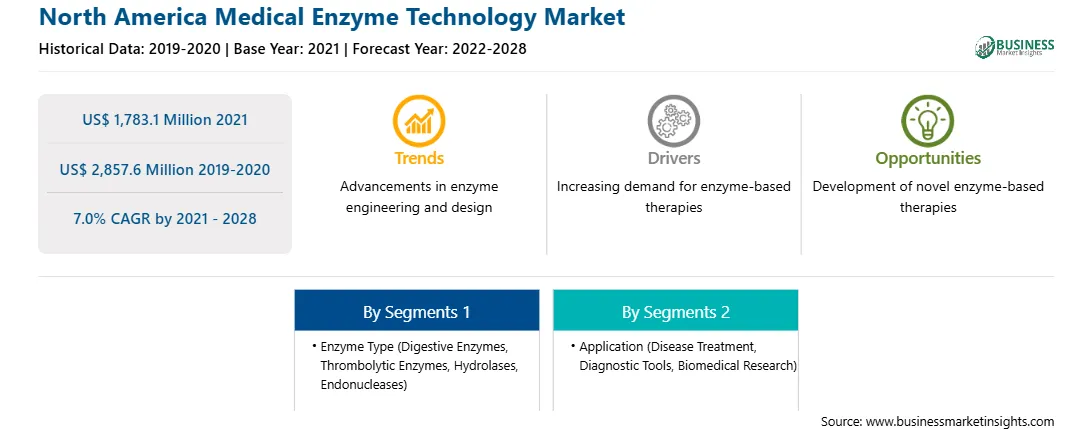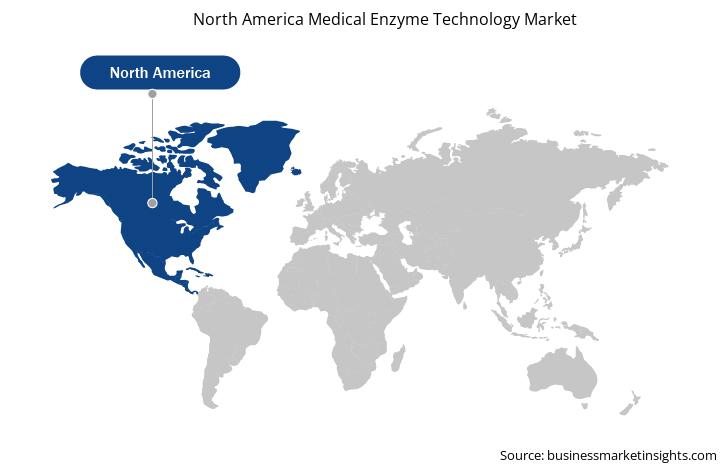Enzymes are proteins produced in living cells of plants, animals, and microorganisms. All living organisms require enzymes for growth and for the production and utilization of energy which is essential for life. In the living cell, enzymes act as catalysts to speed up the chemical reactions which control life processes. Enzymes have been significant industrial products for more than a hundred years. However, the range of potential applications is increasing rapidly. With the advent of recombinant DNA technology, it has become possible to make formerly rare enzymes in large quantities and hence to reduce cost. Also, in pharmaceutical manufacturing, the desire to make chirally pure compounds is leading to new opportunities. Technological advances have facilitated the use of enzymes over an increasingly broad range of process conditions.
Thus, the significant increase in research and development activities is expected to create a significant demand for medical enzyme technology in the coming years, which is further anticipated to drive the medical enzyme technology market.
In the North American region, the US was profoundly affected by the outbreak of the COVID-19 pandemic. The country has marked the highest number of positive patients and still facing the second wave of COVID-19. Across the various healthcare sectors, the effect of a pandemic can be felt, resulting in various changes in the health care industry. Scientists are working together to produce and exchange genomic sequence data information, which can be used in disease detection and control efforts. The US is increasing its ability to track coronavirus mutations and has demand for digestive enzymes. It has also been documented that SARS-CoV-2 infection can cause liver damage, and that abnormal liver function and liver enzymes are associated with the severity of COVID-19. Extreme COVID-19 patients have higher levels of aspartate aminotransferase, alanine aminotransferase, and total bilirubin (TBL) than non-severe COVID-19 patients. Elevated hepatic enzymes are also more common in COVID-19 patients treated in the ICU compared to those not treated in the ICU. During the treatment of the first COVID-19 confirmed case in the United States, there was an overall increase in hepatic enzymes, indicating that SARS-CoV-2 infection would directly affect the liver. All such aspects will add to the future demand for the North America region's Medical Enzyme Technology market.

Strategic insights for the North America Medical Enzyme Technology provides data-driven analysis of the industry landscape, including current trends, key players, and regional nuances. These insights offer actionable recommendations, enabling readers to differentiate themselves from competitors by identifying untapped segments or developing unique value propositions. Leveraging data analytics, these insights help industry players anticipate the market shifts, whether investors, manufacturers, or other stakeholders. A future-oriented perspective is essential, helping stakeholders anticipate market shifts and position themselves for long-term success in this dynamic region. Ultimately, effective strategic insights empower readers to make informed decisions that drive profitability and achieve their business objectives within the market.

| Report Attribute | Details |
|---|---|
| Market size in 2021 | US$ 1,783.1 Million |
| Market Size by 2028 | US$ 2,857.6 Million |
| Global CAGR (2021 - 2028) | 7.0% |
| Historical Data | 2019-2020 |
| Forecast period | 2022-2028 |
| Segments Covered |
By Enzyme Type
|
| Regions and Countries Covered | North America
|
| Market leaders and key company profiles |
The geographic scope of the North America Medical Enzyme Technology refers to the specific areas in which a business operates and competes. Understanding local distinctions, such as diverse consumer preferences (e.g., demand for specific plug types or battery backup durations), varying economic conditions, and regulatory environments, is crucial for tailoring strategies to specific markets. Businesses can expand their reach by identifying underserved areas or adapting their offerings to meet local demands. A clear market focus allows for more effective resource allocation, targeted marketing campaigns, and better positioning against local competitors, ultimately driving growth in those targeted areas.

The Medical enzyme technology market in North America is expected to grow from US$ 1,783.1 million in 2021 to US$ 2,857.6 million by 2028; it is estimated to grow at a CAGR of 7.0% from 2021 to 2028. Biopharmaceuticals are among the growing business segments of the pharmaceutical and biotechnology industries. Since their introduction in 1982, biopharmaceutical drugs have revolutionized the treatment of a broad spectrum of diseases, and they are increasingly used in nearly all medicine branches. Despite the immense time and financial effort required, the market of biopharmaceuticals is rapidly growing. In 2017, India-based Biocon received the US Food and Drug Administration (FDA) approval for Ogivri, a biosimilar to Herceptin (trastuzumab). That is the first biosimilar approved in the US to treat breast and stomach cancer and the second biosimilar approved in the country for cancer treatment.
In terms of enzyme type, the hydrolases segment accounted for the largest share of the North America medical enzyme technology market in 2020. In terms of application, the disease treatment segment accounted for the largest share of the North America medical enzyme technology market in 2020.
A few major primary and secondary sources referred to for preparing this report on the medical enzyme technology market in North America are company websites, annual reports, financial reports, national government documents, and statistical database, among others. Major companies listed in the report are Merck Kgaa, Thermo Fisher Scientific Inc., Novozymes, Takeda Pharmaceutical Company Limited, Agilent Technologies, Inc., Genzyme Corporation, Asahi Kasei Corporation, Promega Corporation, Cytiva, and Amano Enzyme Inc.
By Enzyme Type
By Application
By Country
The North America Medical Enzyme Technology Market is valued at US$ 1,783.1 Million in 2021, it is projected to reach US$ 2,857.6 Million by 2028.
As per our report North America Medical Enzyme Technology Market, the market size is valued at US$ 1,783.1 Million in 2021, projecting it to reach US$ 2,857.6 Million by 2028. This translates to a CAGR of approximately 7.0% during the forecast period.
The North America Medical Enzyme Technology Market report typically cover these key segments-
The historic period, base year, and forecast period can vary slightly depending on the specific market research report. However, for the North America Medical Enzyme Technology Market report:
The North America Medical Enzyme Technology Market is populated by several key players, each contributing to its growth and innovation. Some of the major players include:
The North America Medical Enzyme Technology Market report is valuable for diverse stakeholders, including:
Essentially, anyone involved in or considering involvement in the North America Medical Enzyme Technology Market value chain can benefit from the information contained in a comprehensive market report.